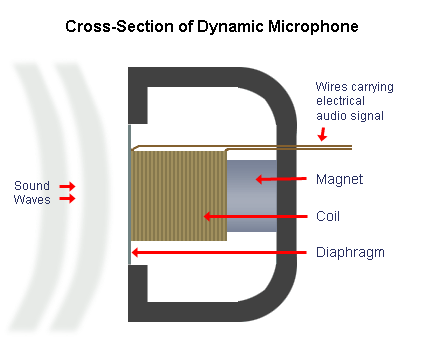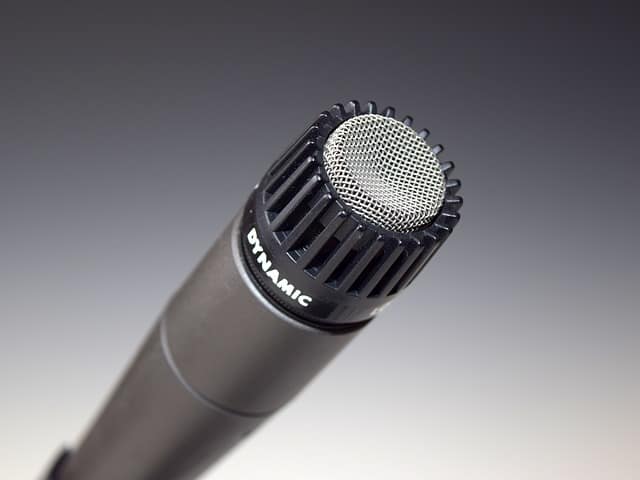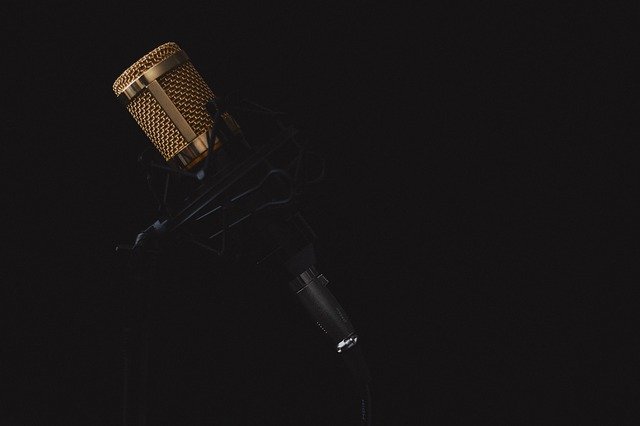What is a Dynamic Microphone?
So, what is a dynamic microphone? First, it’s important to note that microphones work on the electromagnetic principle through a diaphragm that’s affixed to the wire coil.

For the mic microphones, their sound waves will hit the diaphragm (metallic) that’s attached to the wire coil. The diaphragm will vibrate making the magnet(the metallic coil) to create a magnetic field.
The coil’s motion in this magnetic field helps create an electrical signal that matches the sound which is picked – this is a theory referred to as electromagnetic induction.
What is a Dynamic Microphone?
The movement of the mic’s diaphragm helps create the current. Further, as the speed of the motion increases or decreases, so will the current vary. Check these Sound Cards for Music Production.

Dynamic microphones are considered velocity-sensitive. These mics are considered the all-around particularly for recoding studios and around keyboard workstations.
How Does Dynamic Microphone Work?
Also, these dynamic mics will give you well-rounded and mellow sounds. These ones have a unidirectional (cardioid) response pattern.
The microphone filter with the cardioid pattern will filter the wind and noise coming from the backside and thus isolate or preserve the audio source during studio recording.
Dynamic vs Condenser Microphone
First, lest’s discuss a transducer – this will help us understand the differences between dynamic vs condenser mics. So, a transducer is described as is the component inside the microphone that’ll make an electrical signal from the acoustic sound waves it picks up.
1. Dynamic Microphones
Dynamic microphones will combine both a magnet and its voice call to create a mini but effective electrical generator. Thus, when sound waves numb onto the mic’s plastic diaphragm, it’ll vibrate and make the voice coil wire to also vibrate.
The vibrating coil will generate an electrical signal since its surround by a powerful magnetic field. The dynamic mics will thus look more rugged compared to the condenser mics because the former has fewer electrical circuitry.
Therefore, the dynamic mics will comfortably handle harsh conditions including accidental dropping, extreme weather, and high volume. Further, dynamic mics are generally cheaper compared to the condensers.
Therefore, how the mic’s transducer operates will affect if the device will be considered to be a dynamic or condenser mic. Read Also: Wireless Lavalier Mic for DSLR for reporters, conference presentations, and interviews.
Usage?
Dynamic mics will be great for the instruments having a low-to-mid frequency such as electric guitar amps – check these headphones for guitar amps.
Further, these mics have a higher tolerance for different loud instruments (high SPLs) making it great for the horn and drums sections.
Dynamic mics are truly warm compared to condenser mics – and are thus excellent for recoding spoken word – check these microphones for vocals.
However, dynamic mics won’t be very sensitive like the condenser mics – and thus you’ll need to be closer or even produce a louder sound.
Thus for stage performance recoding horns and drums, the dynamic mic will give you a warmer sound.
2. Condenser Microphones
Condenser mics, on the other hand, will have an electrically charged diaphragm as opposed to mechanical one in dynamic mics. Sound waves arriving into the mic will vibrate the metal-coated plastic and will be changed into electrical signals.
Therefore, condenser mics by design will be more fragile compared to the dynamic mics. Thus, they’ll be poor in handling harsh conditions like extreme either, or loud sound.
The condenser mics will require power for its complex circuitry to work effectively – you’ll thus require to provide it from phantom power or batteries – you’ll notice that most audio interfaces use this kind of phantom power.
The condenser mic will have a complex electric circuit and hence it’ll be more expensive. Also, the mics will be more precise and sensitive recording very quality and natural sounds compared to the dynamic mics.
Usage?
On the other hand, condenser mics will function optimally with recording instruments with high-frequency. These are instruments that do not tool loud like live piano, cymbals, and acoustic guitar.
These instruments have a smaller diaphragm and thus work best at high frequencies. Such frequencies will produce lower energy and thus the diaphragm vibrates lesser.
Therefore, condenser microphones will have superior frequency response and some wider dynamic range – thus will pick up softer sounds better. Read Also: Laptop for Video Editing.
Further, the condenser mic diaphragms will be more fragile and hence may get damaged faster in recording too high of a Sound Pressure Level (SPL).
Conclusion
Dynamic mics have numerous applications since they give you great sound but equally rugged to allow easy road traveling.
So, there you have it on the “what is a dynamic microphone?” I’ve also compared dynamic vs condenser microphones.


